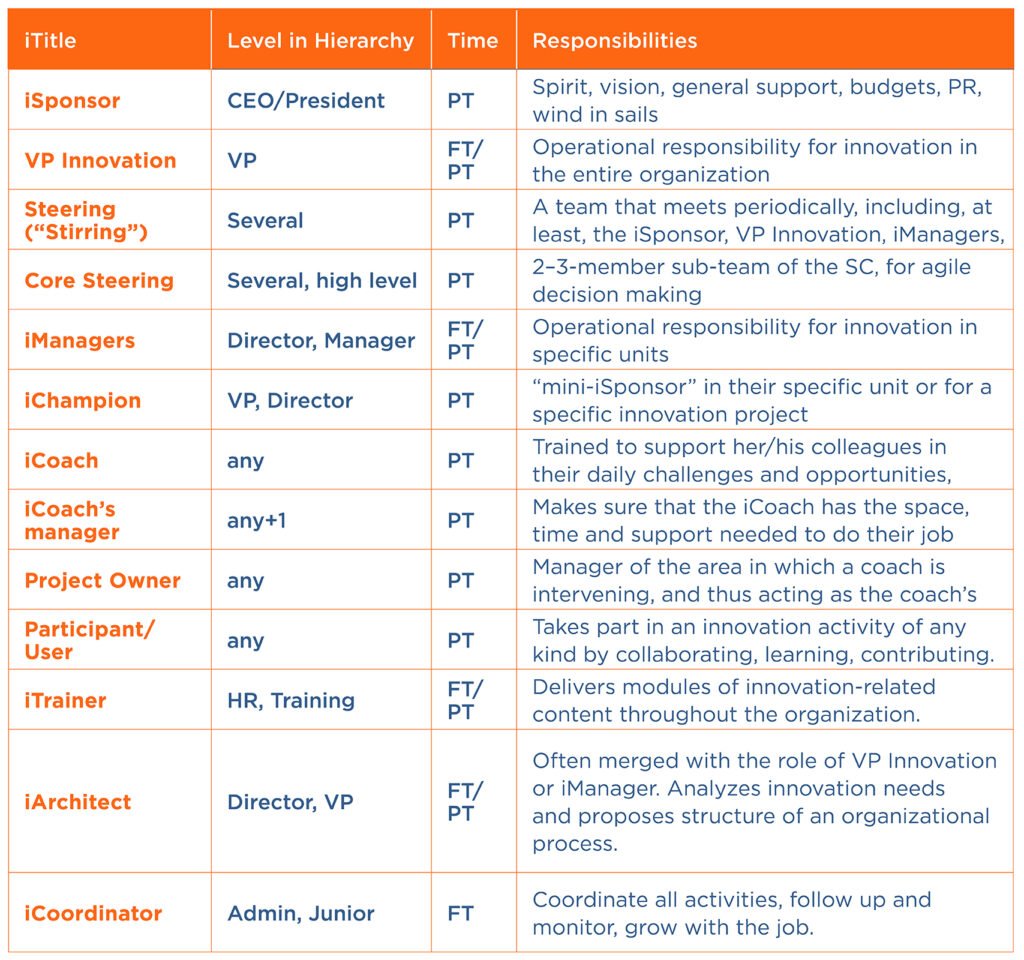Your organization has decided to embark on a program to boost its innovation capabilities, maybe shift the innovation culture or even try to change the organizational culture. Assuming that you will proceed in a structured approach, you will definitely ask yourself whether you need to assign specific innovation-related roles, and if so – which and how.
Like good, annoying stereotypical consultants we offer two pieces of seemingly conflicting advice:
- Avoid as much as possible creating a parallel governance structure, and steer away from overloading the organization with even more unnecessary bureaucracy;
- Make sure that specific innovation roles are defined and that at least some of them will be exercised by full time dedicated associates.
The first of these two is self-explanatory, I believe. The reason for the second is that if you rely exclusively on part timers and on a generalized motivation among the troops, innovation will simply not happen, since an associate’s “real” day job will always take precedence over their innovation assignment. A mix of part- and full-timers can do the job, provided that a proper structure is put in place and managers throughout the corporate ladder are committed to collaborate with the full-timers and support the part-timers.
The “correct” or proper structure obviously varies immensely depending on the organization implementing it. Very few organizations that I am aware of implement all the roles in the table below, and even those who do, don’t persist with all of them for a long time, mostly because not all are needed as a permanent fixture. In fact, as an organization develops and progresses in its innovation journey it will tend to need less of a supporting structure, until, in its ideal end stage, it can completely shed the structure as more and more people innovate in what they do, simply because it is ingrained in their modus operandi and their newly formed thought structures (for a useful definition of innovation, that can help understand what is it exactly that you are driving to achieve, see our post What is Innovation). But meanwhile, on the way to this elusive and lofty goal, here is the perfect, optimal, full blown, often unrealistic-but-still-useful-reference org-tree of innovation governance in a corporation.

Again, it is important to stress that:
- This is a catalogue of many possible options, which only rarely appear in the same organization at the same time;
- This structure obviously applies to large organizations, often multinational;
- Terminology also varies widely. For example, the terms iAmbassador, iCatalyst, iLeader are often used interchangeably with iChampion, iCoach, iManager or even VP Innovation;
- The hierarchical level of those holding the various roles can differ, be higher or lower than the level specified in the table, but note that – as discussed in our post Two Blind Spots – one should take care to drive innovation both from the bottom up, as well as top-down, while heeding the most important agents – middle management. The table above reflects this principle.
In spite of the variability, and the need to adapt roles and responsibilities to the specific organization, we find this list and structure useful, since all of the functions listed have a real and productive role in promoting and driving innovation in an organization. None of the roles mentioned above is make-believe, although they all need to be infused with content and meaning as they are created, and the task is often daunting, given that the person filing them will often be the first in her or his role.
Sixteen years ago, I sat with Oscar, a sad-looking and deflated manager who had just been awarded the title of innovation manager for a division of 8,000 employees. “I like the title and believe that it can be exciting,” he said. Why, then, did he look so forlorn, I asked. “In my former job, colleagues were running in and out of my office all day, my phone was incessantly ringing, everyone needed me. I had a real job. Now,” he sighed, “I’m sitting quietly in my empty office figuring out what to do.” Today, as VP Innovation of the entire 23,000-strong organization, he manages a team of 50 employees, plus several dozens of interns and students in part-time roles, playing a crucial role in the mother company’s ongoing transformation. His team also lends support to the company’s 1200 trained Innovation Coaches, not all of whom are currently active, but many of which have leading roles in promoting innovation in their respective units (click here to be notified about our future posts on Creating an Innovation Coach Community). One could cynically interpret this development in terms of Parkinson’s Law – a new bureaucracy nourishing itself and creating useless jobs, but on the contrary, they are constantly being monitored, their results measured according to agreed-upon indicators (see our posts on Measuring Innovation (Part 1 and Part 2) and found to be greatly contributing to the corporation’s growth and profitability. Time and again we find that, when correctly defined and executed, an innovation governance structure can be the key to drive innovation effectively throughout an organization.
In Part 2 of this nano-series on Roles and Responsibilities, we will dive into some of the roles mentioned in the table above, discuss characteristics of those individuals who can fulfill the tasks and point out some recommended dos and don’ts when defining and performing them.
